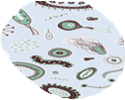Description
Provide students with the story from Part One of the pathway, and continue with more of the story that corresponds to Part Two:
Farmers at Sunrise Farm are planting crops for the season. They spread fertilizer on the field. The fertilizer contains chemical nutrients that help plants grow. Much of the fertilizer is used by the plants or absorbed by the soil, but not all. When it rains, some of the fertilizer goes into the stream by the field and flows into the pond.
Sunrise Farm Pond, like all ponds, has some algae growth. The algae grow slowly and have a very short lifespan. When the fertilizer runs into the pond, the chemical nutrients that help the crops grow also help the algae grow and reproduce much faster than they had previously.
The algae grow thick at the top of the water, which makes the water cloudy and blocks the sunlight from getting to the bottom of the pond where many producers live. As a result, it is difficult for the producers to grow and they eventually die. Normally, in the process of making their food, producers make much of the oxygen the pond needs. As they die, the amount of oxygen in the pond from these producers decreases.
Because algae have a very short lifespan, they die quickly, leaving a large amount of dead algae in the pond. The dead algae are consumed by bacteria, which are decomposers. Like all decomposers, the bacteria use oxygen in their process of consuming/decomposing the dead algae. There are a lot of dead algae, so the bacteria use a lot of the remaining oxygen in the pond.
When one of the farmers checks on the pond a few months after planting the crops, she finds that several of the fish have died.
Why are the fish dying at Sunrise Farm Pond?
After sharing the story, use the Questions to Ask Students in a class discussion to encourage students to consider how their models relate to events in the story.
Questions to Ask Students
- How does the story compare with your thinking about why the fish are dying in Sunrise Farm Pond?
- How does your model represent what is described in the story?
Student Thinking
Some students may now believe that the decomposers are the sole reason for fish death.
Implementation Tip
Part Three will help students develop a complete understanding of the events at Sunrise Farm Pond.
